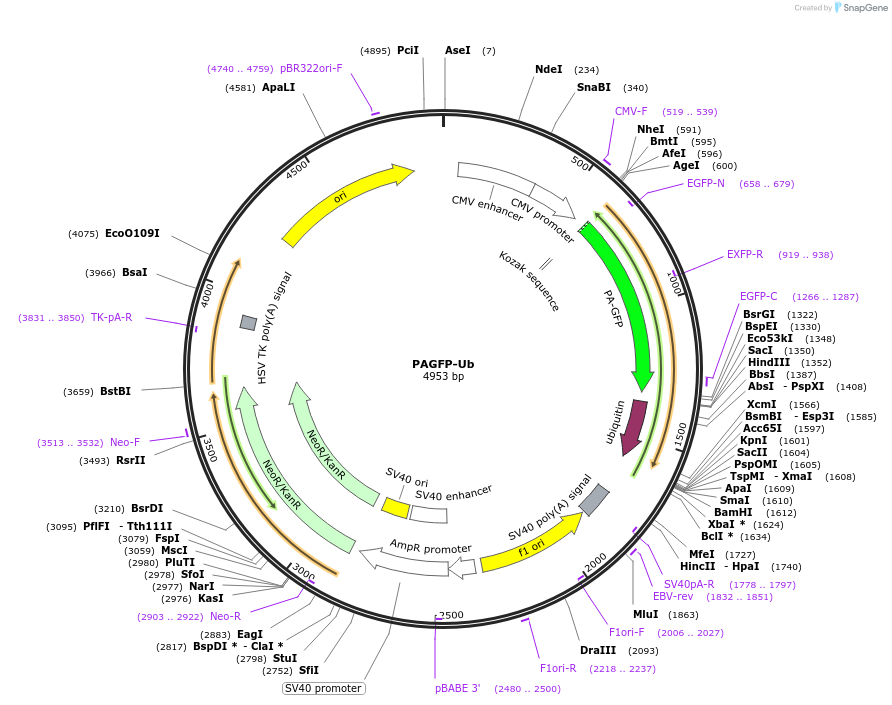-
Depositing Lab
-
Publication
-
Sequence Information
Ordering
| Item | Catalog # | Description | Quantity | Price (USD) | |
|---|---|---|---|---|---|
| Plasmid | 11933 | Standard format: Plasmid sent in bacteria as agar stab | 1 | $89 | |
Backbone
-
Vector backboneEGFP-C1
-
Backbone manufacturerClontech
- Backbone size w/o insert (bp) 4500
-
Vector typeMammalian Expression
-
Selectable markersNeomycin (select with G418)
Growth in Bacteria
-
Bacterial Resistance(s)Kanamycin, 50 μg/mL
-
Growth Temperature37°C
-
Growth Strain(s)DH5alpha
-
Copy numberHigh Copy
Gene/Insert
-
Gene/Insert nameUbiquitin
-
Alt nameUb
-
Alt nameubiquitin
-
SpeciesH. sapiens (human)
-
Insert Size (bp)250
-
Entrez GeneRBX1 (a.k.a. BA554C12.1, RNF75, ROC1)
-
Tag
/ Fusion Protein
- PAGFP (N terminal on backbone)
Cloning Information
- Cloning method Restriction Enzyme
- 5′ sequencing primer EGFP-C (CATGGTCCTGCTGGAGTTCGTG)
- (Common Sequencing Primers)
Resource Information
-
A portion of this plasmid was derived from a plasmid made byPAGFP-C1 was a gift from Jennifer Lippincott-Scwartz.
-
Articles Citing this Plasmid
Terms and Licenses
-
Academic/Nonprofit Terms
-
Industry Terms
- Not Available to Industry
Trademarks:
- Zeocin® is an InvivoGen trademark.
Depositor Comments
PAGFP is a photoactivatable version of GFP. It is essentially the same as the standard EGFP-C1 from clontech, but contains the mutations L64F/T65S/V163A/T203H, and conatins an A206K mutation to disrupt dimerization.
In total, the PAGFP-Ubiquitin insert is 983bp.
These plasmids were created by your colleagues. Please acknowledge the Principal Investigator, cite the article in which the plasmids were described, and include Addgene in the Materials and Methods of your future publications.
-
For your Materials & Methods section:
PAGFP-Ub was a gift from Nico Dantuma (Addgene plasmid # 11933 ; http://n2t.net/addgene:11933 ; RRID:Addgene_11933) -
For your References section:
A dynamic ubiquitin equilibrium couples proteasomal activity to chromatin remodeling. Dantuma NP, Groothuis TA, Salomons FA, Neefjes J. J Cell Biol. 2006 Apr 10. 173(1):19-26. 10.1083/jcb.200510071 PubMed 16606690



